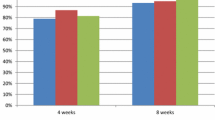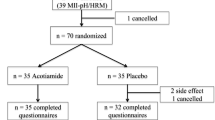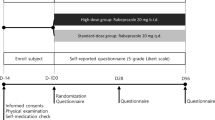Abstract
We sought to evaluate safety and efficacy of IV pantoprazole when used as initial therapy in patients with gastroesophageal reflux disease (GERD) and a history of erosive esophagitis (EE) in a double-blind, placebo-controlled, randomized, parallel-group study. Patients were randomized to 7 days of once-daily IV or oral pantoprazole (40 mg) or placebo. Efficacy variables included maximal acid output, basal acid output, and changes from baseline in frequency/severity of GERD symptoms, and frequency of antacid usage. Seventy-eight patients were randomized (n=26/27/25 [IV/oral/placebo]). Mean maximal acid output was 8.4, 6.3, and 20.9 mEq/h for IV or oral pantoprazole, and placebo, respectively. For pantoprazole versus placebo, maximal and basal acid output were significantly lower (P<.001) and there was a numerical trend toward improved GERD and antacid usage. Both treatments were well tolerated. In conclusion, IV/oral pantoprazole were similarly effective in suppressing basal and pentagastrin-stimulated gastric acid secretion in GERD patients with a history of EE.



Similar content being viewed by others
References
Richter JE, Bochenek W (2000) Oral pantoprazole for erosive esophagitis: a placebo-controlled, randomized clinical trial. Pantoprazole US GERD Study Group. Am J Gastroenterol 95:3071–3080
Kovacs TO, Wilcox CM, DeVault K, Miska D, Bochenek W (2002) Pantoprazole US GERD Study Group B. Comparison of the efficacy of pantoprazole vs. nizatidine in the treatment of erosive oesophagitis: a randomized, active-controlled, double-blind study. Aliment Pharmacol Ther 16:2043–2052
Richter JE, Fraga P, Mack M, Sabesin SM, Bochenek W (2004) Pantoprazole US GERD Study Group. Prevention of erosive oesophagitis relapse with pantoprazole. Aliment Pharmacol Ther 20:567–575
Metz DC, Bochenek WJ (2003) Pantoprazole maintenance therapy prevents relapse of erosive oesophagitis. Aliment Pharmacol Ther 17:155–164
Metz DC, Pratha V, Martin P, Paul J, Maton PN, Lew E, Pisegna JR (2000) Oral and intravenous dosage forms of pantoprazole are equivalent in their ability to suppress gastric acid secretion in patients with gastroesophageal reflux disease. Am J Gastroenterol 95:626–633
Hassan MA, Hobsley M (1970) Positioning of subject and of nasogastric tube during a gastric secretion study. Br Med J 1:458–460
Pratha V, Karlstadt R, Lynn RB, Lane JR, Hogan DL (2001) Gastric pH may not be an accurate indicator of gastric acidity. Am J Gastroenterol 96(Suppl):66
Pratha V, Lynn RB, Karlstadt R, Burton MS, Hogan DL (2003) Gastric pH above 2.5 is of limited use as a measure of acid inhibition. Am J Gastroenterol 98(Suppl):42
Wurzer H, Schutze K, Bethke T, Fischer R, Luhmann R, Riesenhuber C (1999) Efficacy and safety of pantoprazole in patients with gastroesophageal reflux disease using an intravenous-oral regimen. Austrian Intravenous Pantoprazole Study Group. Hepatogastroenterology 46:1809–1815
Lew EA, Pisegna JR, Starr JA, Soffer EF, Forsmark C, Modlin IM, Walsh JH, Beg M, Bochenek W, Metz DC (2000) Intravenous pantoprazole rapidly controls gastric acid hypersecretion in patients with Zollinger-Ellison syndrome. Gastroenterology 118:696–704
van Rensburg CJ, Hartmann M, Thorpe A, Venter L, Theron I, Luhmann R, Wurst W (2003) Intragastric pH during continuous infusion with pantoprazole in patients with bleeding peptic ulcer. Am J Gastroenterol 98:2635–2641
Morris J, Karlstadt R, Blatcher D, Field B, McDevitt M (2003) Intermittent intravenous pantoprazole rapidly ac-hieves and maintains gastric pH greater than or equal to 4.0 compared with continuous infusion H2-receptor antagonist in intensive care unit patients. Crit Care Med 31:A34
Acknowledgments
This study was sponsored by Wyeth Pharmaceuticals.
Author information
Authors and Affiliations
Corresponding author
Rights and permissions
About this article
Cite this article
Pratha, V., Hogan, D.L., Lynn, R.B. et al. Intravenous Pantoprazole as Initial Treatment in Patients With Gastroesophageal Reflux Disease and a History of Erosive Esophagitis: A Randomized Clinical Trial. Dig Dis Sci 51, 1595–1601 (2006). https://doi.org/10.1007/s10620-006-9108-2
Received:
Accepted:
Published:
Issue Date:
DOI: https://doi.org/10.1007/s10620-006-9108-2




